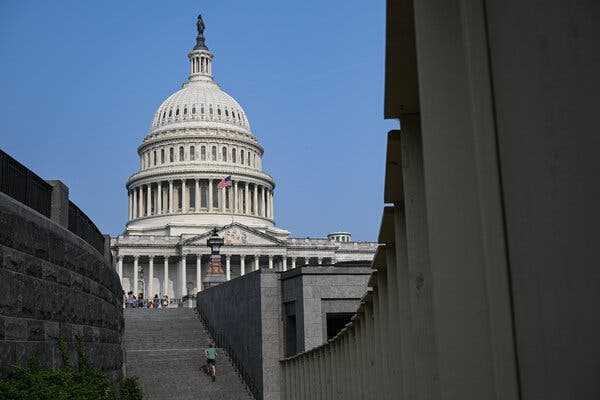The Congressional Budget Office score does not include side deals hashed out between the Biden administration and Speaker McCarthy.
-
Send any friend a story
As a subscriber, you have “>10 gift articles to give each month. Anyone can read what you share.
Give this article

The New York Times estimates the agreement will actually reduce discretionary spending by about $136 billion, compared to what the government was projected to spend, spread over two years.
A crucial question for the bipartisan debt-limit deal is deceptively complicated: How much would it actually reduce federal spending?
The answer depends on whether you are considering the entire deal — including side agreements not written into the legislative text — or just what is technically in the bill. And the tally grows or shrinks dramatically depending on what you think a future Congress will do about spending.
After accounting for all its spending limits and related accounting tricks, The New York Times estimates the agreement will actually reduce discretionary spending by about $55 billion next year, compared with baseline forecasts, and by another $81 billion in 2025.
That’s the bottom-line savings: $136 billion, compared to what the government was projected to spend, spread over two years. Everything else is in flux.
Republicans claim a much higher total spending cut: $2.1 trillion over a decade. That’s based on an analysis of the agreement by the Congressional Budget Office. And it is based on a ton of policy decisions going Republicans’ way for the next several years. Most important, that number assumes Congress votes to implement four years of optional, nonenforceable spending caps that follow the two years of hard caps in 2024 and 2025. It’s possible, but the deal in no way requires it to happen.
The budget office also offered a score of the bill just based on the two enforceable years of caps. It found that over a decade, the caps would save the government about $1.5 trillion in spending and interest on the debt. Most of that savings, though, comes in the last eight years of the decade, after the caps lift.
The budget office assumes that when the caps are gone, Congress will just go back to essentially increasing spending in line with rising prices. So if you reduce spending for a couple of years, as the caps do, that ratchets down spending, because it just starts growing again off a lower base. That’s a possible outcome for the next decade, but Congress could very well decide to go right back to big spending increases — which would negate those projected savings.
So what about the two years where the caps are binding? The budget office finds significant savings there — about $250 billion in total for the two years. But even that number might be too high, because the analysis does not account for the added spending included in the side deals.
Factoring in that added spending — using White House estimates of where they would leave base discretionary spending levels in 2024 and 2025 — reduces the projected savings to about $136 billion. That’s probably the floor of what the spending caps will translate to, in terms of spending cuts.
Jim Tankersley is a White House correspondent with a focus on economic policy. He has written for more than a decade in Washington about the decline of opportunity for American workers, and is the author of “The Riches of This Land: The Untold, True Story of America’s Middle Class.” @jimtankersley
- Give this article
Source: nytimes.com



